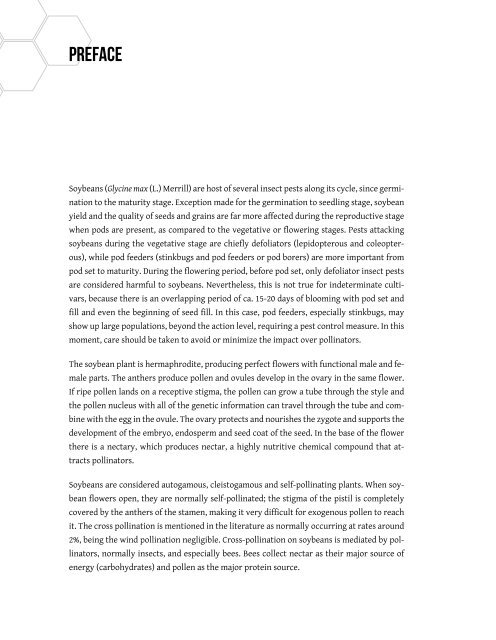Soybean and Bees
Create successful ePaper yourself
Turn your PDF publications into a flip-book with our unique Google optimized e-Paper software.
PREFACE<br />
<strong>Soybean</strong>s (Glycine max (L.) Merrill) are host of several insect pests along its cycle, since germination<br />
to the maturity stage. Exception made for the germination to seedling stage, soybean<br />
yield <strong>and</strong> the quality of seeds <strong>and</strong> grains are far more affected during the reproductive stage<br />
when pods are present, as compared to the vegetative or flowering stages. Pests attacking<br />
soybeans during the vegetative stage are chiefly defoliators (lepidopterous <strong>and</strong> coleopterous),<br />
while pod feeders (stinkbugs <strong>and</strong> pod feeders or pod borers) are more important from<br />
pod set to maturity. During the flowering period, before pod set, only defoliator insect pests<br />
are considered harmful to soybeans. Nevertheless, this is not true for indeterminate cultivars,<br />
because there is an overlapping period of ca. 15-20 days of blooming with pod set <strong>and</strong><br />
fill <strong>and</strong> even the beginning of seed fill. In this case, pod feeders, especially stinkbugs, may<br />
show up large populations, beyond the action level, requiring a pest control measure. In this<br />
moment, care should be taken to avoid or minimize the impact over pollinators.<br />
The soybean plant is hermaphrodite, producing perfect flowers with functional male <strong>and</strong> female<br />
parts. The anthers produce pollen <strong>and</strong> ovules develop in the ovary in the same flower.<br />
If ripe pollen l<strong>and</strong>s on a receptive stigma, the pollen can grow a tube through the style <strong>and</strong><br />
the pollen nucleus with all of the genetic information can travel through the tube <strong>and</strong> combine<br />
with the egg in the ovule. The ovary protects <strong>and</strong> nourishes the zygote <strong>and</strong> supports the<br />
development of the embryo, endosperm <strong>and</strong> seed coat of the seed. In the base of the flower<br />
there is a nectary, which produces nectar, a highly nutritive chemical compound that attracts<br />
pollinators.<br />
<strong>Soybean</strong>s are considered autogamous, cleistogamous <strong>and</strong> self-pollinating plants. When soybean<br />
flowers open, they are normally self-pollinated; the stigma of the pistil is completely<br />
covered by the anthers of the stamen, making it very difficult for exogenous pollen to reach<br />
it. The cross pollination is mentioned in the literature as normally occurring at rates around<br />
2%, being the wind pollination negligible. Cross-pollination on soybeans is mediated by pollinators,<br />
normally insects, <strong>and</strong> especially bees. <strong>Bees</strong> collect nectar as their major source of<br />
energy (carbohydrates) <strong>and</strong> pollen as the major protein source.


